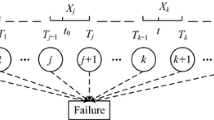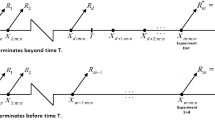Abstract
In this paper, the reliability analysis of the inverted Nadarajah–Haghighi (INH) distribution under an adaptive type-I progressive hybrid censoring scheme (AT-I PHCS) has been investigated. The unknown parameters of the INH distribution based on AT-I PHCS have been estimated using Bayesian and non-Bayesian methods. The asymptotic and two bootstrap confidence intervals are also calculated, as well as maximum likelihood estimates of the unknown parameters. The maximum product spacing estimation method based on AT-I PHCS has been introduced. Bayesian estimates of the unknown parameters are obtained based on symmetric (squared error) loss function. Furthermore, the Markov chain Monte Carlo (MCMC) technique is used to compute the Bayesian estimators and the associated credible intervals. Bootstrap confidence intervals have been discussed for parameters of INH based on AT-I PHCS. A real-life data set is used of progressively censored samples for transformer insulation life testing and compare tests included three levels of constant voltage, which were 35:4, 42:4, and 46:7kv, respectively. Finally, a simulation study is conducted to evaluate the estimators' performance.



Similar content being viewed by others
Data availability
The data is included in Sectection V ANALYSIS OF TRANSFORMER TURN.
Code availability
Function “maxlik” of “maxLik” package and “copula” package in the R program has been used.
References
Nadarajah S, Haghighi F (2011) An extension of the exponential distribution. Statistics 45(6):543–558
Lemonte AJ (2013) A new exponential-type distribution with constant, decreasing, increasing, upside-down bathtub and bathtub-shaped failure rate function. Comput Stat Data Anal 62:149–170
Bourguignon M, Lima MDCS, Leão J, Nascimento AD, Pinho LGB, Cordeiro GM (2015) A new generalized gamma distribution with applications. Am J Math Manag Sci 34(4):309–342
Lemonte AJ, Cordeiro GM, Moreno-Arenas G (2016) A new useful three-parameter extension of the exponential distribution. Statistics 50(2):312–337
Cícero RB, Alizadeh M, Cordeiro GM (2018) The beta Nadarajah-Haghighi distribution. Hacettepe J Math Statistics 47(5):1302–1320
Tahir MH, Cordeiro GM, Ali S, Dey S, Manzoor A (2018) The inverted Nadarajah-Haghighi distribution: estimation methods and applications. J Stat Comput Simul 88(14):2775–2798
Khan MN, Saboor A, Cordeiro GM, Nazir M, Pescim RR (2018) A weighted Nadarajah and Haghighi distribution. UPB Sci Bull, Series A: Appl Math Phys 80:133–140
Kumar D, Kumar M (2019) A new generalization of the extended exponential distribution with an application. Annal Data Sci 6(3):441–462
Sheikh AK, Ahmad M, Ali Z (1987) Some remarks on the hazard functions of the inverted distributions. Reliab Eng 19(4):255–261
Lehmann EL, Shaffer JP (2012) Inverted distributions. In Selected Works of EL Lehmann. Springer, Boston, MA (pp. 833–836)
Vodˇa VG (1972) On the inverse Rayleigh distributed random variable. Rep Statis App Res JUSE 19(4):13–21
Keller AZ, Kamath ARR (1982). Alternate reliability models for mechanical systems. ESA Reliability and Maintainability p 411–415(SEE N 83–20178 10–38)
Keller AZ, Kamath ARR (1982) Reliability analysis of CNC machine tools. Reliab Eng. 3:449–473
Lin CT, Duran BS, Lewis TO (1989) Inverted gamma as a life distribution. Microelectron Reliab 29(4):619–626
Sharma VK, Singh SK, Singh U, Agiwal V (2015) The inverse Lindley distribution: a stress-strength reliability model with application to head and neck cancer data. J Ind Prod Eng 32(3):162–173
Barco KVP, Mazucheli J, Janeiro V (2017) The inverse power Lindley distribution. Commun Statist-Simul Comput 46(8):6308–6323
Epstein B (1954) Truncated life tests in the exponential case. Annal Math Stat 25(3):555–564
Childs A, Chandrasekar B, Balakrishnan N, Kundu D (2003) Exact likelihood inference based on Type-I and Type-II hybrid censored samples from the exponential distribution. Ann Inst Stat Math 55(2):319–330
Y Shi (2022) Advances in Big Data Analytics: Theory Algorithm and Practice. Springer, Singapore
DL Olson, Y Shi (2007) Introduction to business data mining. McGraw-Hill/Irwin, New York
Y Shi, Y Tian, G Kou, Y Peng, J Li (2011) Optimization based data mining: theory and applications. Springer Science Business Media
Tien JM (2017) Internet of things, real-time decision making, and artificial intelligence. Annal Data Sci 4(2):149–178
Kundu D, Joarder A (2006) Analysis of Type-II progressively hybrid censored data. Comput Stat Data Anal 50(10):2509–2528
Childs A, Chandrasekar B, Balakrishnan N (2008) Exact likelihood inference for an exponential parameter under progressive hybrid censoring schemes. In Statistical models and methods for biomedical and technical systems Birkhäuser Boston, (pp. 319–330)
Ng HKT, Kundu D, Chan PS (2009) Statistical analysis of exponential lifetimes under an adaptive Type-II progressive censoring scheme. Naval Research Logistics (NRL) 56(8):687–698
Balakrishnan N, Kundu D (2013) Hybrid censoring: Models, inferential results and applications. Comput Stat Data Anal 57(1):166–209
Lin CT, Huang YL (2012) On progressive hybrid censored exponential distribution. J Stat Comput Simul 82(5):689–709
Lin CT, Chou CC, Huang YL (2012) Inference for the Weibull distribution with progressive hybrid censoring. Comput Stat Data Anal 56(3):451–467
Lindley DV (1980) Approximate bayesian methods. Trab Estad Investig Oper 31(1):223–245
Tierney L, Kadane JB (1986) Accurate approximations for posterior moments and marginal densities. J Am Stat Assoc 81(393):82–86
Mohammed N M (2014) Analysis of exponential distribution under adaptive type-I progressive hybrid censored competing risks data. Pak J Stat Oper Res 10(2):229–245
Ashour SK, Nassar M (2017) Inference for Weibull distribution under adaptive type-I progressive hybrid censored competing risks data. Commun Stat-Theory Methods 46(10):4756–4773
Ismail AA (2016) Statistical inference for a step-stress partially-accelerated life test model with an adaptive Type-I progressively hybrid censored data from Weibull distribution. Stat Pap 57(2):271–301
Nassar M, Dobbah SA (2020) Analysis of reliability characteristics of bathtub-shaped distribution under adaptive Type-I progressive hybrid censoring. IEEE Access 8:181796–181806
Cheng RCH, Amin NAK (1983) Estimating parameters in continuous univariate distributions with a shifted origin. J Roy Stat Soc: Ser B (Methodol) 45(3):394–403
Ranneby B (1984) The maximum spacing method. An estimation method related to the maximum likelihood method. Scand J Stat 11:93–112
FPA Coolen MJ Newby 1990 A note on the use of the product of spacings in Bayesian inference. Department of Mathematics and Computing Science, University of Technology
Ng HKT, Luo L, Hu Y, Duan F (2012) Parameter estimation of three-parameter Weibull distribution based on progressively type-II censored samples. J Stat Comput Simul 82(11):1661–1678
Singh KR, Singh SK, Singh U (2016) Maximum product spacings method for the estimation of parameters of generalized inverted exponential distribution under Progressive Type II Censoring. J Stat Manag Syst 19(2):219–245
Almetwally EM, Almongy HM (2019) Maximum product spacing and Bayesian method for parameter estimation for generalized power Weibull distribution under censoring scheme. J Data Sci 17(2):407–444
Alshenawy R, Al-Alwan A, Almetwally EM, Afify AZ, Almongy HM (2020) Progressive type-II censoring schemes of extended odd Weibull exponential distribution with applications in medicine and engineering. Mathematics 8(10):1679
Almongy HM, Alshenawy FY, Almetwally EM, Abdo DA (2021) Applying transformer insulation using weibull extended distribution based on progressive censoring scheme. Axioms 10(2):100
Almetwally EM, Almongy HM, Rastogi MK, Ibrahim M (2020) Maximum product spacing estimation of Weibull distribution under adaptive type-II progressive censoring schemes. Annal Data Sci 7(2):257–279
Almongy HM, Almetwally EM, Alharbi R, Alnagar D, Hafez EH, Mohie El-Din MM (2021) The Weibull generalized exponential distribution with censored sample: estimation and application on real data. Complexity 2021:1–15
El-Sherpieny ESA, Almetwally EM, Muhammed HZ (2020) Progressive Type-II hybrid censored schemes based on maximum product spacing with application to Power Lomax distribution. Physica A 553:124251
Alshenawy R, Sabry MA, Almetwally EM, Almongy HM (2021) Product spacing of stress–strength under progressive hybrid censored for exponentiated-gumbel distribution. Comp, Mater Continua 66(3):2973–2995
Greene WH (2012) Econometric Analysis, 7th edn. Pearson Prentice-Hall, Upper Saddle River, New Jersey
Dey S, Singh S, Tripathi YM, Asgharzadeh A (2016) Estimation and prediction for a progressively censored generalized inverted exponential distribution. Stat Methodol 32(1):185–202
Metropolis N, Rosenbluth AW, Rosenbluth MN, Teller AH, Teller E (1953) Equations of state calculations by fast computing machines. J Chem Phys 21(6):1087–1091
Robert CP, Casella G (2004) The metropolis-hastings algorithm. In: Robert CP, Casella G (eds) Monte Carlo statistical methods. Springer, New York, pp 267–320
Van Ravenzwaaij D, Cassey P, Brown SD (2018) A simple introduction to Markov Chain Monte-Carlo sampling. Psychon Bull Rev 25:143–154
Chen MH, Shao QM (1999) Monte Carlo estimation of Bayesian credible and HPD intervals. J Comput Graph Stat 8(1):69–92
Nelson WB (2009) Accelerated testing: statistical models, test plans, and data analysis. John Wiley Sons, NY, USA New York
Pakyari R, Balakrishnan N (2012) A general-purpose approximate goodness-of-fit test for progressively type-II censored data. IEEE Trans Reliab 61(1):238–244
Acknowledgements
The authors thank the editor and the reviewer for careful reading of the research article and constructive comments that greatly improved this paper. Also, all those who help in creating or revision this work.
Funding
The authors received no specific funding for this study.
Author information
Authors and Affiliations
Contributions
INH distribution based on AT-I PHCS have been obtained. Bayesian and non-Bayesian estimation methods have been discussed. The maximum product spacing estimation method based on AT-I PHCS has been introduced. the real-life data set is used of progressively censored samples for transformer insulation life testing and compare tests including three levels of constant voltage.
Corresponding author
Ethics declarations
Conflict of interest
The authors declare that they have no conflicts of interest to report regarding the present study.
Ethical statements
All of the followed procedures were in accordance with the ethical and scientific standards. This article does not contain any studies with human participants performed by the author.
Additional information
Publisher's Note
Springer Nature remains neutral with regard to jurisdictional claims in published maps and institutional affiliations.
Appendix 1
Appendix 1
See Tables
10,
11,
12,
13,
14,
15,
16,
17,
18.
Rights and permissions
About this article
Cite this article
Abo-Kasem, O.E., Almetwally, E.M. & Abu El Azm, W.S. Inferential Survival Analysis for Inverted NH Distribution Under Adaptive Progressive Hybrid Censoring with Application of Transformer Insulation. Ann. Data. Sci. 10, 1237–1284 (2023). https://doi.org/10.1007/s40745-022-00409-5
Received:
Revised:
Accepted:
Published:
Issue Date:
DOI: https://doi.org/10.1007/s40745-022-00409-5




